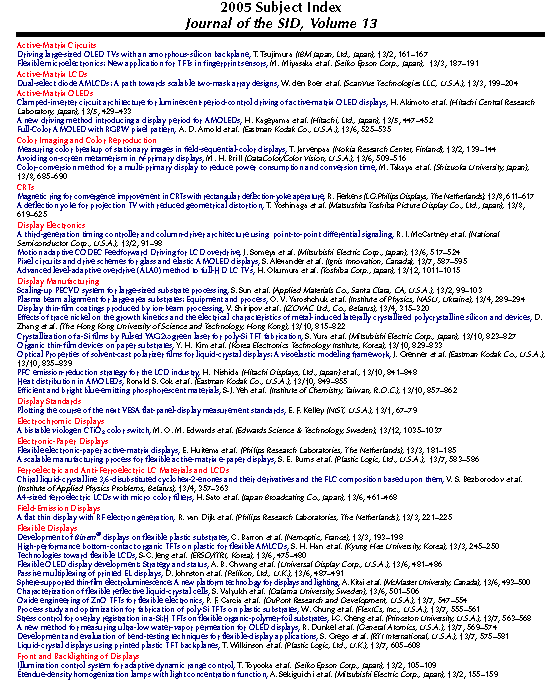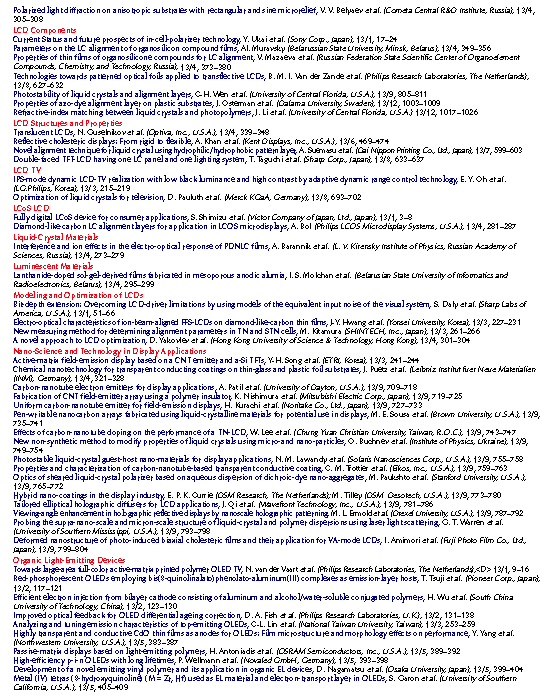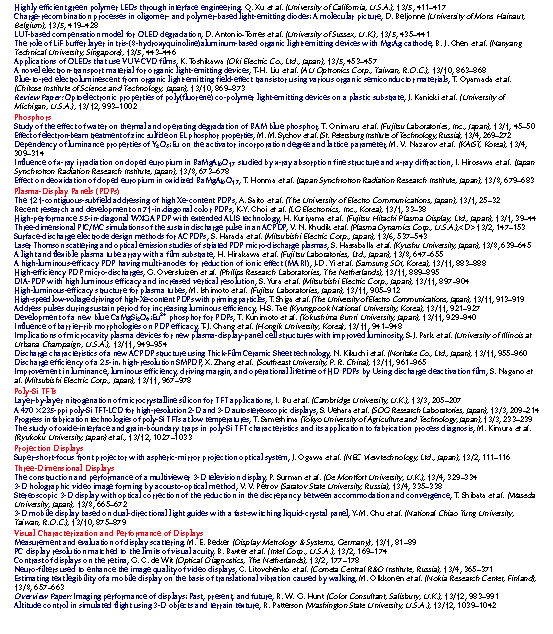A preview of the papers appearing in the December 2005 issue of theJournal of the SID, available on-line atwww.SID.org.
Edited by Aris Silzars
Imaging performance of displays: Past, present, and future*
Robert W. G. Hunt
Color Consultant
*Overview paper.
Abstract — Some display devices that were tried unsuccessfully in the past are reviewed briefly. Then the display devices that are in use at present are described and their advantages and disadvantages discussed. Properties where improvements are needed include greater consistency between pictures displayed from the same signals on different devices, greater color gamut, less impairment by ambient illumination, and better resolution. Finally, consideration is given to some of the ways in which these needs may be met.
It is a common experience that the picture quality produced from the same signals on different devices is significantly different. A lecture prepared on a CRT monitor looks different when viewed on a laptop LCD, and different again when displayed by an LCD or DMD projector. The factors in the devices that contribute to these differences include the luminance dynamic response function, the color of the white, the colors of the primaries, the angle of viewing for older LCDs, and the luminance of the surround. (Although consistency can be improved by using color-management profiling tools, this places an additional burden on the user and can be only partially successful; it is therefore desirable to remove the causes of the inconsistencies.)
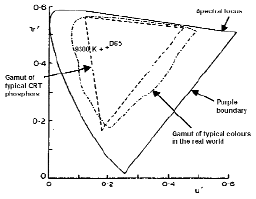
FIGURE 1 — The dashed-line triangle is the chromaticity gamut for typical CRT phosphors. The chain-dotted line represents the gamut of colors typically occurring in the real world. The continuous line shows the spectral locus and purple boundary.
Optoelectronic properties of poly(fluorene) co-polymer light-emitting devices on a plastic substrate*
Jerzy Kanicki
Shu-Jen Lee
Yongtaek Hong
Chia-Chen Su
University of Michigan
*Review paper.
Abstract — The optoelectronic properties of red, green, and blue poly(fluorene) co-polymer light-emitting devices (PLEDs) on a plastic substrate having a multi-layered structure with water vapor and oxygen transmission rates of less than 10–5 g/cm2-day-atm and 10–7 cc/cm2-day-atm, respectively, are reported. A semitransparent thin metal multi-layer (i.e., Au/Ag/Au or Ag/Au/Ag) is placed between the plastic substrate and the ITO coating, achieving a low sheet resistance of 12–13 Ω/4 and an adequate optical transmission greater than 75%. A wider color gamut and a maximum emission efficiency of 0.7, 10, and 1.7 cd/A for red, green, and blue PLEDs, respectively, was obtained. Finally, a simple equivalent-circuit model was used to simulate the current-density–voltage characteristics of PLEDs.
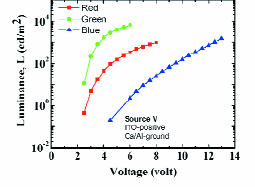
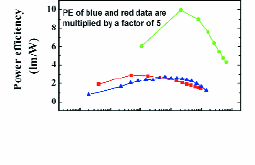
Properties of azo-dye alignment layer on plastic substrates
Jesper Osterman
Au Ping Tong
Kent Skarp
Vladimir Chigrinov
Hoi Sing Kwok
Dalarna University
Abstract — The alignment properties of the azo-dye photo-alignment material SD-1/SDA-2 on plastic substrates are investigated. Important liquid-crystal cell parameters, such as azimuthal and polar anchoring energy, pretilt angle, voltage-holding ratio, and the corresponding electro-optical properties are presented. Excellent alignment with high anchoring energy can be achieved with a polarized UV dose less than 1.0 J/cm2. A reflective six-digit flexible passive-matrix-driven TN-LCD for smart-card applications showing excellent electro-optical properties is demonstrated.
To demonstrate the alignment-layer quality on plastic substrates, a six-digit reflective passive-matrix-driven flexible TN-LCD was fabricated. To maintain a uniform cell gap during bending of the display, adhesive spacers were chosen. The liquid-crystal mixture MLC-6809-000 (Merck) was used in order to operate at the second Gooch & Tarry condition for an 8-μm cell gap. The display prototype was exposed to mechanical testing according to the ISO/IEC 10373-1:1998(E) standard, a test method for identification cards. After 1000 cycles of dynamic and torsional bending stress no noticeable change in the alignment quality, cell gap, or the electro-optical properties of the tested displays could be observed, hence the prototypes have the same performance after the mechanical bending tests required for smart cards. In order to investigate the thermostability of the alignment, the display was heated to 100°C for 1 hour and the electro-optical properties were measured once more after the thermal cycle. Again, no noticeable change in the electro-optical properties could be observed.

FIGURE 11 — Reflective flexible TN-LCD with SD-1/SDA-2 alignment layer mounted in smart-card prototype.
Advanced level-adaptive overdrive (ALAO) method applicable to full-HD LC TVs
Haruhiko Okumura
Masahiro Baba
Kazuki Taira
Akira Kinno
Toshiba Corp.
Abstract — The development of an advanced level-adaptive overdrive (ALAO) method applicable to full-HD LC TVs is reported, which makes it possible not only to reduce the gray-level response time to less than one fourth, but also to improve the S/N ratio for still images by 10 dB; and further to reduce the circuit cost for the LAO method to almost half that of the prior LAO circuit. The ALAO method was applied to a full-HD LC front projector with 1.84 Mpixels and a screen size larger than 100 in., and high-quality full-HD moving images were obtained.
In 1990, a level-adaptive overdrive (LAO) method with TV moving-image display capability that enables the reduction of gray-level response times to less than one-fourth that of the conventional method, i.e., less than one field period, was developed. The technical aspects of the LAO method was demonstrated at SID '92 for the first time. Subsequently, the LAO method was analyzed and the relationship between the optimized overdrive voltage and LCD panel characteristics was clarified. A recursive-type LAO method for slow-response-time LCDs with a bi-level response time of more than 16.7 msec was proposed. Almost 5–10 years later, the recently proposed driving concepts by K. Nakanishi et al., which are similar to our original LAO method or recursive-type LAO method, indicate the useful-ness of our original LAO concept. However, thus far a 16:9-aspect-ratio full-HD moving-image display capablity having a less than 16-msec of gray-level response time had not been achieved.
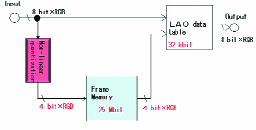
FIGURE 10 — Advanced LAO circuit block diagram.
Refractive-index matching between liquid crystals and photopolymers
Jun Li
Greg Baird
Yi-Hsin Lin
Hongwen Ren
Shin-Tson Wu
University of Central Florida
Abstract — Refractive indices of two photocurable polymers, NOA65 and NOA81 (Norland Optical Adhesive), and two series of Merck liquid crystals, E-series (E44, E48, and E7) and BL-series (BL038, BL003 and BL006), and two UCF high-birefringence liquid-crystal mixtures were measured using an Abbe refractometer in the visible spectral region and 15–55°C temperature range. Some liquid crystals have excellent index matching with NOA65 in the red, while some fit better in the blue spectral region. To validate this index-matching property found in the material level, some polymer-dispersed liquid-crystal devices were prepared. Good correlations between material and device performances were obtained.
NOA65 (Norland Optical Adhesive) is a commonly used photocurable polymer because its refractive index (np ~ 1.52) is close to theno of many commercial LC mixtures. On the other hand, NOA81 has a higher refractive index (np ~ 1.56), which is close to the no of our UCF high-birefringence LC mixtures. In this study, the refractive indices of NOA65 with six Merck LC mixtures, and NOA81 with two UCF high birefringence LC mixtures using a multiwavelength Abbe refractometer (Atago DR-M4) was compared. Before UV curing, NOA65 and NOA81 are clear and colorless liquids. The measurement of the monomers is fairly simple. However, in a practical device, such as a PDLC, all the monomers are cured to form a polymer matrix. Therefore, it is more meaningful to measure the refractive index of the cured polymers than the monomers.
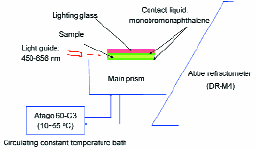
FIGURE 1 — The experimental setup for measuring the refractive index of cured polymer films: NOA65 and NOA81.
The study of oxide-interface and grain-boundary traps in poly-Si TFT characteristics and its application to fabrication process diagnosis
M. Kimura
T. Yasuhara
K. Harada
D. Abe
S. Inoue
T. Shimoda
Ryukoku University
Abstract — The study of oxide-interface and grain-boundary traps in poly-Si TFT characteristics is reviewed. The subthreshold swing and threshold voltage mainly depend on the density of the oxide-interface traps (Dit), while the transistor mobility mainly depends on the density of grain-boundary traps (Dgb). These device properties are applied to diagnose two fabrication processes: plasma treatment and gate-oxide deposition. It is found that oxygen (O) plasma treatment reduces Dit. This seems to be because O plasma treatment has the ability to terminate the dangling bonds, but O plasma species do not diffuse into the poly-Si. A model is proposed by comparing the bond energy of the Si–H and Si–O–H. On the other hand, plasma-enhanced chemical-vapor deposition (PECVD) of tetraethylorthosilicate (TEOS) for gate oxide increases Dgb. This seems to be because hydrogen (H) plasma species in the TEOS-PECVD damage the grain boundaries. A model is proposed by considering the reaction processes: hydrolysis, dehydration and bonding, and H plasma species generated during the dehydration.
In laser-crystallized poly-Si TFTs, few trap states exist in grains, while many trap states exist at oxide interfaces and at grain boundaries. The oxide-interface traps and grain-boundary traps are some of the main determinants of TFT characteristics. The dependence of the TFT characteristics on the trap densities has already been analyzed in other reports. However, these reports employ some assumptions and approximations for these trap states that may not be consistent with actual conditions. Therefore, an extraction technique to correctly separate and extract the density of oxide-interface traps (Dit) and grain-boundary traps (Dgb) has recently been developed by the authors.
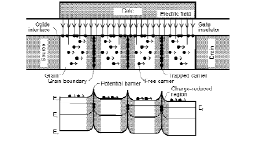
FIGURE 1 — Structure of the poly-Si TFT with the oxide interface and grain boundaries.
A bistable viologen–TiO2 color switch
Mårten O. M. Edwards
Roger Persson
Uppsala University
Abstract — The electro-optical characteristics of a pixel configuration used in electrochromic viologen–TiO2 passive-matrix devices are studied. The configuration has two stable color states in an intermediate voltage regime. Color switching is performed by applying voltages outside this regime. The bistability is due to electrolyte-additive controlled electron trapping in the color-changing viologen molecules.
Electrochromic viologen–TiO
2 displays are, especially due to their high brightness and wide angular viewing regime, promising for electronic-paper applications. The active component in such displays is a porous network of TiO
2 nanoparticles on conducting glass, with electrochromic viologen molecules attached to the TiO
2 surface. To realize electrochromic passive-matrix displays with high resolution and millions of pixels, it is advantageous if the pixels behave like bistable color switches,
i.e., the pixel color should be independent of voltage, but history-dependent, in an intermediate voltage regime. It should be possible to switch color by applying a voltage outside the intermediate regime. After switching, when going back to the inter-mediate regime, the new color should be preserved for a long time.
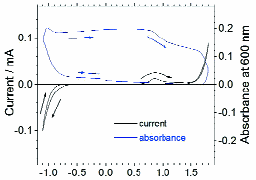
FIGURE 1 — Optical cyclic voltammograms of the bistable two-electrode cells. The scan direction is indicated by arrows.
Altitude control in simulated flight using 3-D objects and terrain texture
Robert Patterson
George A. Geri
Brian P. Dyre
Shama C. Akhtar
Christine M. Covas
Byron J. Pierce
Washington State University
Abstract — In this study, the effects of manipulating the properties of 3-D objects and terrain texture on the control of altitude in simulated flight has been investigated. 3-D objects were found to be as effective as terrain texture for controlling altitude, and this result was interpreted as suggesting that both terrain texture and 3-D objects can serve as effective carriers of information about motion parallax and optical expansion and contraction. The present results, which were obtained using a vertically defined flight task, are inconsistent with the findings of Patterson et al., who reported that 3-D objects were more effective than terrain texture for controlling a horizontally defined heading task. The present results indicate that, when terrain texture is present, the motion parallax or optical expansion associated with the presence of 3-D objects does not improve altitude control.
With respect to the visual cues necessary for accurate altitude control, it is plausible that 3-D objects containing horizontal contours (e.g., buildings) would be important for an altitude task that involved active control in the vertical dimension. Based on the study by Patterson et al., it would be expected that increasing the density, and possibly the width, of the 3-D objects, would improve altitude control by providing increased motion-parallax information. In addition, because the present study involved changes in altitude, another relevant visual cue may be the optical expansion and contraction that occurs when an observer gets closer to or farther from a ground surface.
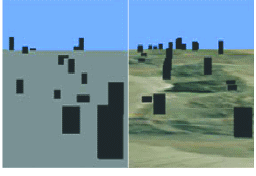
FIGURE 1 — Examples of the homogeneous gray terrain texture (left panel) and the real-world terrain texture (right panel) with 3-D objects (buildings). The two panels depict the density of 0.2 buildings/km2. A gray terrain texture and real-world terrain texture without 3-D objects were also tested.
